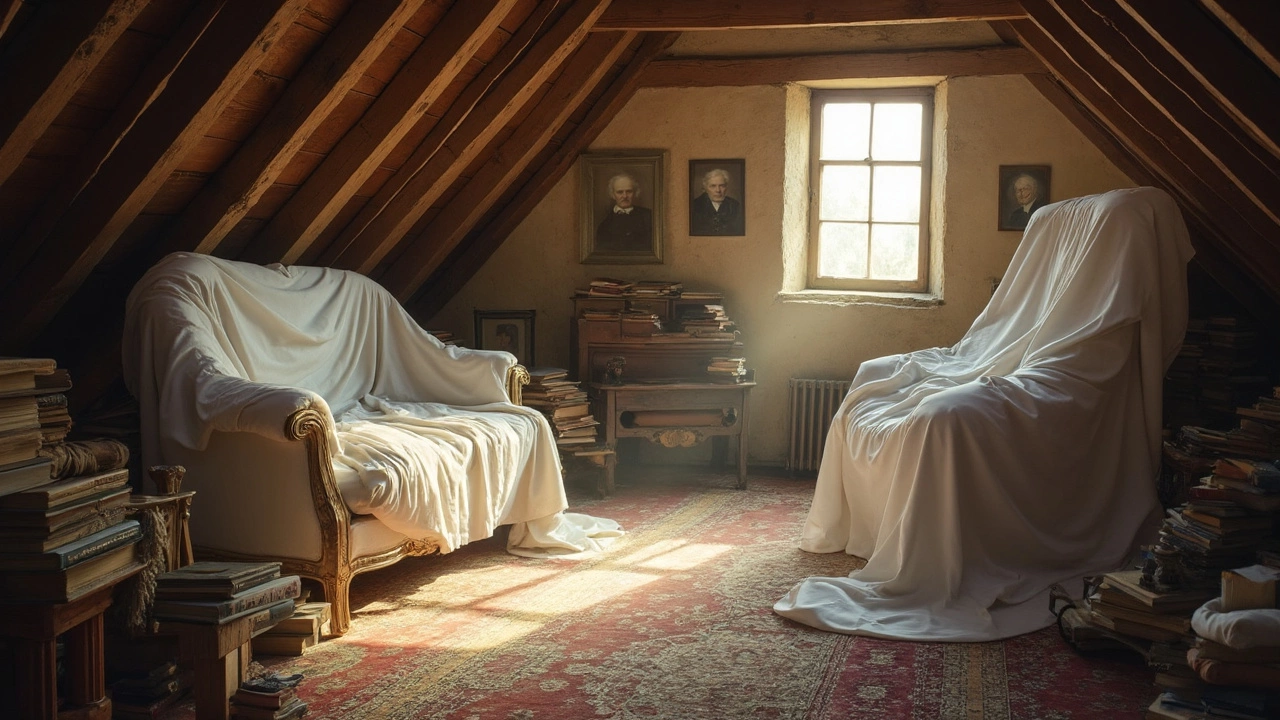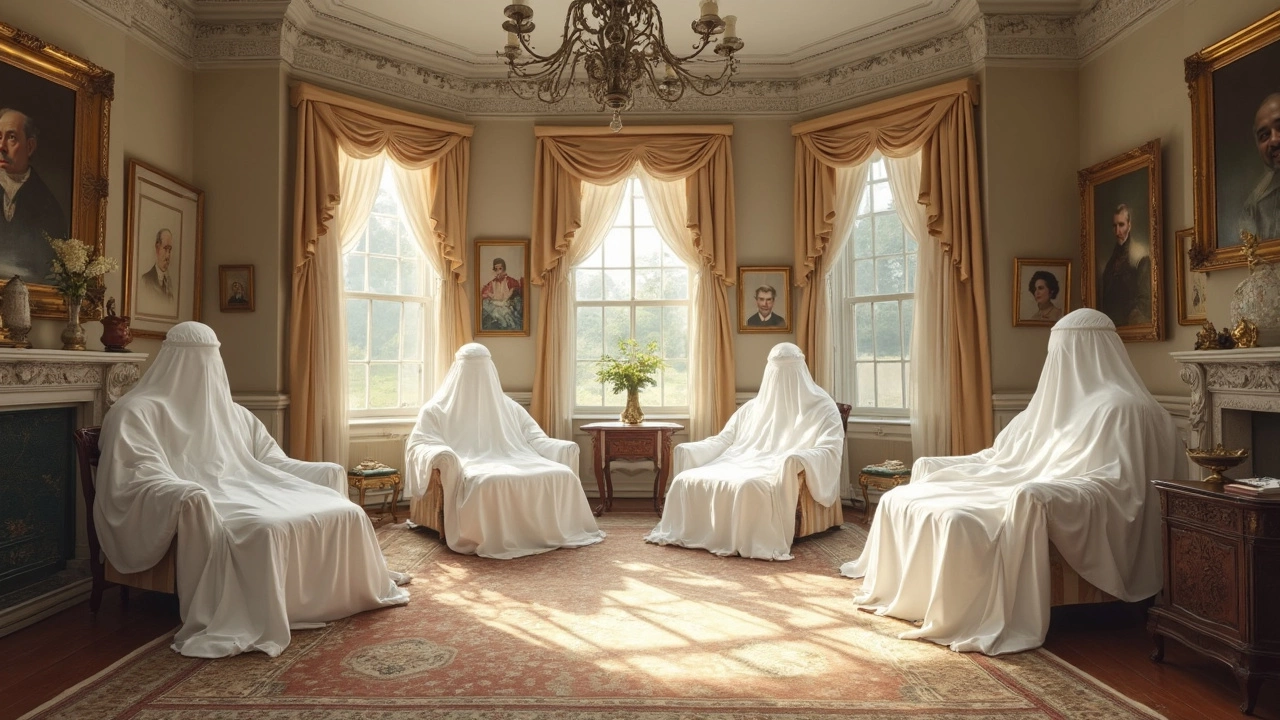Ever walked into a room that looks straight out of an old movie, with white sheets draped over all the furniture? It's not just an artsy choice—there's good reason for it. Covering furniture with white sheets is a practical method to keep dust and grime at bay. Imagine this: your couch sitting unused for months. Dust accumulates, and next thing you know, it's a sneeze-fest. Those sheets act like simple, breathable shields.
And here's something many folks might not know—white sheets help keep sunlight from fading your furniture. Sunlight, while great for us, isn't so kind to upholstery and wood finishes. White reflects light, so it acts as a barrier that keeps colors vibrant longer. So, those sheets are like sunscreen for your furniture!
When planning longer storage, it's about picking the proper cover. Using cotton or linen sheets ensures breathability, preventing mildew or moisture build-up. Plus, they're easy to throw in the wash whenever needed. These practical little details can make a world of difference in how well-preserved your furniture stays over time.
- Historical Reasons for Covering Furniture
- Protection from Dust and Dirt
- Sunlight and Color Fading
- Ideal Materials for Covering
- Practical Tips for Furniture Storage
Historical Reasons for Covering Furniture
Ever wondered why people started tossing white sheets over their furniture in the first place? It's got some history behind it. Back in the day, especially during the Victorian era, homes with many rooms weren't used all the time. Fancy parlors or drawing rooms sat empty for many months, particularly during hot seasons when families escaped to their countryside homes.
Now, imagine these rooms being left unused; they became magnets for dust and sometimes pests. By covering furniture with those white sheets, homeowners could go off without worrying about returning to dusty, potentially damaged furniture. It served as an easy solution to avoid cleaning chores right after coming back. Call it the original 'dust jacket' for furniture!
Furniture protection was also vital in grand homes that had rich woods and luxurious fabrics, often expensive and imported from faraway lands. These materials needed some TLC, and the sheets provided a forward-thinking yet straightforward way to ensure longevity.
Also, covering furniture wasn't just about dust—it was about a strange fashion trend, too. Ever heard of mourning periods? Families covered their homes as part of mourning rituals. People used black crepe drapes and sheets when someone died, creating a somber atmosphere, but once life went back to normal, those whites came back out to keep things clean and respectful.
In a time without our modern cleaning appliances, these sheets were a smart, efficient way to maintain a home’s appearance with minimal effort. So, if you thought covering furniture was just an old-fashioned quirk, there's actually quite a practical legacy behind it!
Protection from Dust and Dirt
Covering your furniture with white sheets isn't just about aesthetics; it's a savvy way to keep your pieces safe from dust and dirt. Think about it: dust doesn't play favorites. It settles everywhere, and once it finds a cozy spot on your couch, armchair, or coffee table, it tends to stick around and can be a nightmare to clean.
But why white sheets, specifically? First off, they're easy to maintain. You can throw them in the wash anytime, and boom, they’re fresh and ready to protect again. And since they’re white, it’s also easy to spot when they need a wash.
Dust might not seem like a big deal, but over time, it accumulates and can even cause damage. It can scratch surfaces, especially if it becomes mixed with things like pet hair (I’m looking at you, Luna and Milo), skin cells, or even oils from hands or spills.
- White sheets act as a barrier that prevents dust and dirt from settling directly onto your furniture’s surface.
- They help keep allergens at bay, which is a bonus if you or anyone in your home has allergies.
- Using sheets can also prevent accidental spills or drops from making a mess on your furniture directly.
A practical tip: make sure the sheets are tucked in snugly around your furniture to avoid any gaps. If you're using them for longer storage, it’s worthwhile to check and retuck them periodically. That way, they stay effective in doing what they do best.

Sunlight and Color Fading
Ever left something in the sun for too long and noticed it turning a weird color? That's what happens to your beloved couch if it catches too many rays. Sunlight streaming in through your windows can be harsh on furniture, especially when left unattended. It doesn’t take a rocket scientist to know that sun exposure leads to color fading, dulling those vibrant hues you initially fell in love with.
Here's why: Ultraviolet (UV) rays make the dyes in your upholstery break down over time. Leather and fabric are particularly at risk. Even wood finishes can suffer, losing their luster and developing a washed-out appearance. So, unless you want your furniture to adopt a sun-bleached style, mind how much sun it's getting.
Covering your pieces with white sheets is a super straightforward trick. Why white sheets, you ask? Well, they work like a mirror, bouncing the sunlight away rather than absorbing it. This reflective quality helps prevent the UV rays from wreaking havoc on your furniture’s colors.
Let's hit you with a quick tip: consider rotating furniture occasionally or adjusting blinds and curtains to limit direct sunlight exposure. For those serious about preserving pieces, using white sheets is one of the easiest and most effective hacks. Keeping your colors popping is a breeze when you take these small steps. Remember, a little prevention now can save you from a big color crisis later!
Ideal Materials for Covering
Picking the right material for covering your furniture is like choosing the right jacket for the weather—it matters more than you might think! Let's start with the basics: cotton and linen. These materials are champs when it comes to breathability, which means they help prevent any pesky moisture build-up that can lead to mildew or mold.
Cotton sheets are a top pick because they're soft, lightweight, and easy to care for. You can easily throw them in the wash if they get dusty or grimy. Plus, they won't scratch or damage delicate surfaces, making them a safe bet for all kinds of furniture.
On the other hand, if you're dealing with more prolonged storage, you might want to consider canvas. It’s a bit sturdier, providing extra protection against scratches or dents, especially if you've got pets around—trust me, my dog Milo sometimes gets curious!
If you're worried about sunlight, which can seriously fade those vibrant fabrics, consider using white sheets. They reflect the sun's rays, helping keep your furniture looking fresh. Besides, white gives a clean, sleek appearance that makes everything look neat, even in storage mode.
Let’s not forget about the wonders of organic options. Organic cotton is becoming a hit for those wanting to keep things natural. It's just like regular cotton, but it's grown without harmful chemicals. It's clean, it's green, and it's perfect if you want to be a bit eco-friendly while you're at it.
Here's a handy tip: Avoid using plastic covers unless it's a temporary measure. While they might seem like good moisture barriers, they can trap in humidity and lead to mold issues. So, stick with breathable materials to keep your furniture happy and healthy.

Practical Tips for Furniture Storage
Storing furniture isn't just about tossing a white sheet over the top and calling it a day. There are some key steps to make sure your items stay in tip-top shape. Let's dig into how you can do this right.
First off, give everything a good scrub down. Clean furniture means you'll be storing it without any hidden dirt or grime causing issues during storage. Dust, vacuum, and if needed, use a mild cleaner. This sets the stage for when it's time to cover them.
When choosing materials to cover your furniture, keep in mind that natural is better. Opt for fabrics like cotton or linen because they breathe well. This helps to avoid moisture buildup which can lead to mildew or rot. You don't want to find your favorite armchair ruined because the cover led to a damp disaster.
Placement matters too. Avoid storing furniture directly on cold concrete as it can draw up moisture. Consider putting a pallet or thick rug underneath to lift and protect it. This small move can be a lifesaver for keeping your pieces in pristine condition.
- Disassemble When Possible: If you can break down furniture, do it. This not only saves space but also reduces the risk of damage.
- Avoid Plastic Covers: Plastic traps moisture, encouraging mold. If you must use it, ensure it's not in direct contact.
- Keep Temperature and Humidity in Check: Extreme conditions can warp wood and damage fabrics. If you have control, aim for a stable environment.
- Label Everything: Sounds simple, but it makes setting up later a breeze. Knowing where each piece belongs saves a ton of headache.
If you've got other items to store alongside furniture, avoid stacking heavy things on top. It may seem like a space-saver, but it also means major pressure damage over time.
Finally, if storage spans months or years, check on your furniture periodically. A quick pop-in to make sure everything's holding up is worth it for peace of mind. This way, when it’s time to bring it all back out, you’re not dealing with any shockers.


Write a comment